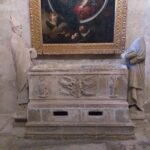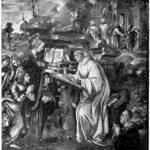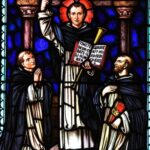St. Cecilia
Saint Cecilia
St. Cecilia: The Melodious Martyr Who Transcended Time
When they lived:
St. Cecilia, the patron saint of musicians, lived during the early centuries of the Common Era. Historical records suggest that she was born around the 2nd or 3rd century AD. While precise dates of her life remain shrouded in the mists of time, her legacy has endured through the ages.
Where they lived:
St. Cecilia’s life unfolded in the vibrant city of Rome, which was not only the heart of the Roman Empire but also a melting pot of cultures and ideas. Rome, at the time, was a bustling cosmopolitan center, providing a unique backdrop for St. Cecilia’s remarkable tale.
Notable world events during the time of their life:
- The Antonine Plague (165-180 AD): Amidst the splendor of the Roman Empire, a deadly pandemic, known as the Antonine Plague, ravaged the population. Historians believe it was either smallpox or measles. This catastrophe affected countless lives, bringing both sorrow and resilience to the communities it touched.
- The Golden Age of the Roman Empire (96-180 AD): St. Cecilia lived during what is often referred to as the “Golden Age” of the Roman Empire. This era was marked by relative peace, prosperity, and the flourishing of arts and culture. Poets, philosophers, and artists left an indelible mark on history during this period.
- The Han Dynasty in China (206 BC – 220 AD): While St. Cecilia lived in the West, the Han Dynasty reigned in the East. This prosperous era saw significant advancements in science, technology, and governance, which laid the groundwork for China’s future development.
- Ptolemaic Egypt (305-30 BC): Although St. Cecilia’s time saw the decline of the Ptolemaic Kingdom, the legacy of ancient Egypt still influenced the region’s art, religion, and scholarship. The Great Library of Alexandria remained a beacon of knowledge during this period.
- The Invention of the Water Wheel (3rd century AD): Around the time of St. Cecilia, the ingenious water wheel was invented, revolutionizing industries and agricultural practices. This innovation played a crucial role in powering mills, making life easier for people in various regions.
Her patronage:
St. Cecilia is renowned as the patron saint of musicians, poets, and all who appreciate the power of music. Her association with music arose from the legend of her steadfast faith and martyrdom. According to the story, even as she faced persecution and death, she sang joyously to God, inspiring the hearts of those around her. Thus, she became a symbol of unwavering devotion and the harmonious union of spirituality and artistic expression.
Over the centuries, countless musicians, artists, and composers have sought her intercession for inspiration and guidance in their creative pursuits. Her patronage extends to not only classical musicians but also modern artists of all genres. Celebrated through art, music, and literature, St. Cecilia’s influence continues to reverberate through time, resonating with the souls of those who seek beauty and spirituality in the world. Her enduring legacy as a martyr and a patron saint has made her an emblem of devotion, courage, and the profound impact of music on the human experience.
Young Cecilia
History has it that Cecilia was born in the second century, around 200 AD, into a rich and noble family in Rome. Cecilia prayed often and had promised God she would remain a virgin till death.
But her parents would have none of that. Cecilia was forced into marriage with a pagan nobleman called Valerian. And young Cecilia was lost on how to keep the vow she made.
At her wedding with Valerian, it was said that Cecilia sat apart, singing in her heart to God. At the same time, musicians played music at the feast.
The Wedding Night
Cecilia wouldn’t consummate her marriage to Valerian. She told her husband about her vow and assured him that an angel guarding her would punish him if he sexually violated her.
Quite unbelievable, Valerian asked to be shown the angel. Ceciliare replied that he could only see the angel if he went to the third milestone via Appia and got baptized. Curious, Valerian set off to be baptized.
Valerian was baptized by Pope Urbanus, who was then Bishop of Rome. He found an angel standing beside Cecilia on his return, crowning her with a bouquet of roses and lilies.
The New Converts
It has been said ” that action speaks louder than voice,” so it was for Valerian. Having witnessed Cecilia’s words to be accurate, he joined her commitment to a celibate marriage. When Valerian’s brother Tibertius heard of the angel and his baptism, he also got baptized.
Together, both brothers dedicated their lives to burying the martyrs killed every day by the Turcius Almachius, city prefect. It was a dangerous time to be a Christian in Rome.
Eventually, both brothers were arrested and presented before the prefect. Maximus, the city’s prefect executioner, was ordered to kill the brothers.
However, Maximus, stunned by their faith, got converted too. The brothers were executed after refusing to offer sacrifice to the gods of Rome with Maximus.
Undaunted Cecilia
Following her husband and brother-in-law’s murder, one would have expected Cecilia to reconsider her Christian position, but that was not the case. If anything, their deaths became another reason to preach the gospel of Christ.
According to history, Cecilia continued preaching the gospel. She was able to convert over 400 people, who were baptized mainly by Pope Urbanus.
Cecilia was soon arrested and sentenced to death by suffocation in her own bath. She was shut in, and the tub heated to a terrifying temperature, but Cecilia was miraculously saved unharmed.
Alarmed by her survival, Almachius, the city prefect, ordered her execution. Legend has it that Cecilia was struck three times with a sword to the neck and was not beheaded. The executioner fled, leaving her in a pool of her own blood.
It was recorded that Cecilia lived for three days. She preached and prayed for the people who came to her. She donated her wealth to the poor and left a legacy that her house should be converted into a church.
Virgin and Martyr
Cecilia’s death is said to have occurred around 230 AD. Pope Urbanus buried her among other bishops of Rome and confessors in the Catacomb of Callistus. Her feast day is November 22.
She died a virgin, just like she had vowed to God, and was martyred for her faith.
5 Interesting Facts About St. Cecilia
- Except for the Blessed Virgin Mary, St. Cecilia is one of the seven
women mentioned by name during the Roman Catholic Eucharistic
Celebration. - In 1599, her body was exhumed and found to be incorrupt.
- Do you know why her picture is always depicted with her playing the
organ? It is because St. Cecilia is the patron of music and
musicians. - She became the light in her home. Her pagan husband was converted.
and was later canonized a saint. - St. Cecilia and her husband, St. Valerian, are two of the few saints
couples that had a spiritual marriage. Their marriage never
consummated by choice.
Prayer to St. Cecilia
O glorious St. Cecilia, virgin and martyr, you won the martyr’s crown without renouncing your love for Jesus, the delight of your soul. We ask that you help us to be faithful in love for Jesus so that in communion with the saints, we may praise him twice our song for rejoicing for the blood that he shed, which gave us the grace to accomplish His will in our hearts. Amen



